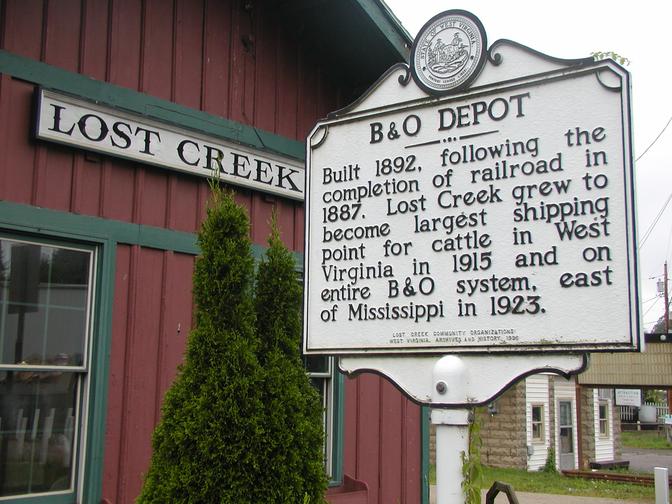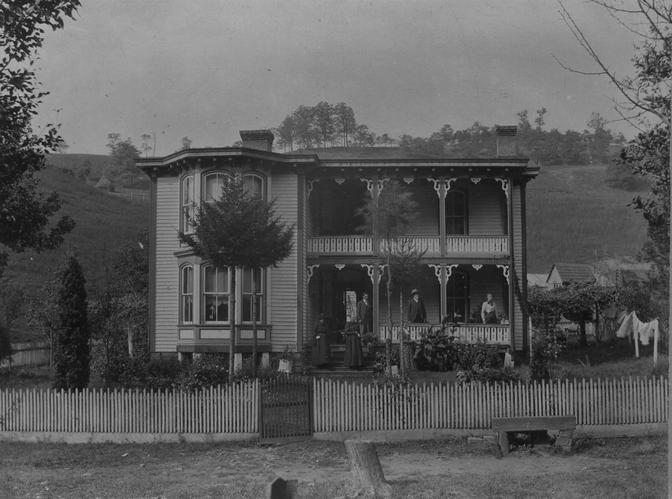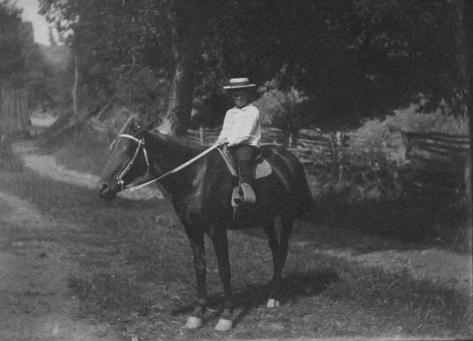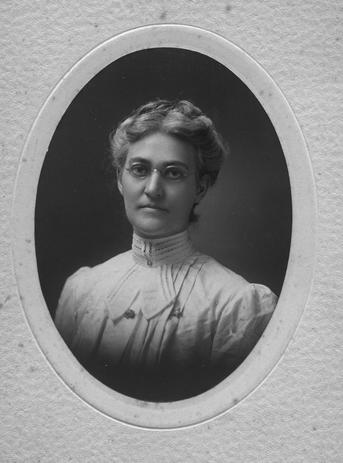
| Next Chapter | Previous Chapter | |
| Chapter 37: Rats | Contents | Chapter 35: Ground Hogs |
What I have to tell here concerns Booth Bond, my Great Grandfather’s farming. He lived on Hacker’s Creek across the creek from the mouth of Rover’s Run. The farm was purchased by his father, Brumfield Bond, in 1832 from Abraham Wolf. Booth raised cattle as his principal enterprise. His pasture was divided, and he would not put animals on grass until it was four inches tall. He is the source of a family rule of thumb for getting through the winter on the available hay, too. “Have half of your hay left the first of February.” This timing implies grazing late in the fall and the insecurity of the date you could turn out to pasture in the Spring, often about the fifteenth of April.
Booth bought calves in the neighborhood and kept them until they were four years old. (Our beef cattle now seldom see much more than two years.) At four they reached full size and they were called “export cattle” because they were not sold locally. My uncle, Ernest Bond, who has helped me with some of these details, claims Booth sold 65 head a year. This represents a great deal of money for the time, $9100. The house he lived in was built for $6400, cash expenditure (doubtless with much family labor contribution, and a hired carpenter or two).
Export cattle were the major domestic product of West Virginia in the years when the eastern cities had reached large size and before the railroads opened the West. Booth would buy calves locally for 3 or 4 cents per pound, and keep them until four years old. When finished (without tasting anything but mothers milk, grass and hay) they weighed as much as 2200 pounds, and lost about 200 pounds while being driven over the roads to Baltimore. There they were worth 7 cents a pound, while the local market would pay 5 cents for “finished” cattle. The walk was accomplished in about two weeks. I don’t know the route, possibly up to what is now Rt. 50 to cross the mountains, but there must have been places over the mountains where there was no fence on one or both sides of the road. Evidently there was little or no organized crime against drovers. Remarkably, turkeys (which are notoriously “bird-brained,” wild, foolish) were moved to Baltimore the same way, and pigs, which were also notoriously difficult to control.
There is a newspaper article in a picture frame on the wall in the community building at Lost Creek taken from a Clarksburg paper in 1915 which states that Lost Creek is the largest shipping point for cattle on the B&O railroad between St. Louis and Baltimore, a statistic taken from the railroad’s records.
(Illustration 36-1)

Historical sign in Lost Creek
(This is a later date than we were talking about in the previous paragraph, of course.) The reason for this was the excellent grass. Cattle were shipped in from the west and fattened on the bluegrass and white clover in Harrison, Lewis, Doddridge and surrounding counties, then driven back to the railroad and sent on East.
The Booth Bond family took in paying overnight guests in later years, since there was no tavern or inn in the neighborhood. (The labor fell mostly to Rebecca, his wife, and the daughters, no doubt.) This doesn’t seem to have been as a result of financial pinch but simply as the result of opportunity. The visitors would have provided a better view of the world beyond the local community, and a sort of entertainment, too.
The Bonds raised Hereford cattle. I risked being kicked out of the family when I changed to Angus. I did this because of the severe pink eye problems we had at the Lost Creek farm. Calves with one bad eye grow as well, but do not sell as well. Two bad eyes are a disaster. And you feel so sorry for cattle that have to suffer. I am now trying Red Angus, a breed that has a lot of technical data. They calculate “expected progeny differences,” for all breeds now, but the Red Angus people have done a lot more thinking, and have a larger data set than the more traditional breeds. Red Angus are more common in Canada than black Aberdeen Angus, and are very common in the West.
Booth Bond kept very careful financial records, and a diary, which I have a copy of. The hills were very steep, not even well adapted to horses. Haymaking must have been very tedious, perhaps largely done by hand. By the second decade of the twentieth century, with the coming of the railroad, the financial pinch must surely have been on. Booth and Rebecca’s many children were growing up, and the original land was surrounded by other farms, so expansion was not possible. My grandfather, T. M. Bond, opted out to the Lost Creek farm, first as a renter, and later as owner. Moses Van Horn, who owned it, was a brother of his mother, Rebecca Van Horn Bond, Booth Bond’s wife. All Booth’s other children left, too. Both Booth and Rebecca died in Salem, then a robust oil and gas center, having lived long lives.
(Illustration 36-2)

The Booth Bond house on Rover’s Run, a branch of Hackers Creek in Upshur County around 1900. Notice the haystack on the hill to the left rear, which is protected by rails.
Before trucking, most prosperous farms had a set of scales to weigh the cattle, or you could use your neighbors’ scales for a small fee. These were still around in the sixties, when I began to get my stride in farming. They were rather simple affairs, using a series of levers and a few small weights. There was a larger weight, sixty pounds, I think, that was set on the scales, and one made some adjustments to calibrate it.
(Illustration 36-3)

My father ready for church in the road in front of the house above, about 1905
Castration of male calves destined for consumption is demanded by the market. This has been the practice for hundreds of years. Now, almost all calves, male and female, are given a pellet of female hormones in the ear to promote faster growth. In Europe bull calves are kept “intact,” and are not allowed much exercise, which also helps produce the “marbled” meat in demand. This “marbled” muscle tissue has a small amount of fat interleavened in the muscle which produces the “juicy” steaks people like so well. Now we castrate the bull calves at two to six months. My grandfather did this job when the calf was first born.
Now hay is cut as soon as dry weather begins in the spring, late May or early June. This is always later than the time recommended. The ideal time is when the grass is in the “boot” stage, the seed head about ready to move out of the leaf-like sheath in which it develops. The plant has maximum nutritive value at this time. This can be done where there is irrigation and leads to an extra cutting. We get two, or with fertilization after each cutting, three cuttings. Apparently, in the remote past, hay was cut one time, in August or September, to get the original growth and the regrowth at one time. If the hay was cut with a scythe, this would be a considerable saving in labor, but much of the grass would be dead, and low in feed value. Hay was sometimes salted in years past, to make it more palatable. This is a practice I witnessed only once in my lifetime, in Oliver Criss’ barn.
Aside Medicine certainly has seen some of the greatest changes that have taken place from the Civil War times in which my great grandfather came to maturity. By then there were trained doctors who were able to do such things as set bones and deliver babies much better than their predecessors. Child bearing before that time was exceedingly hazardous business, and midwives would deliver one child and go on to the next without washing, carrying infection. Three wives in a husband’s lifetime were not unusual, and divorce was not the cause, either.
By Booth Bond’s time, elementary sanitation was known to the educated and the aware, even if not practiced by the masses. Medical service was doubtless better in the cities than in the country, but that differential has not completely disappeared today. The medicines were crude inorganic compounds and derivatives of plants and animals and were usually dispensed by the doctor in rural areas. As a result, it was not uncommon for a doctor to become addicted to some of the medicines.
(Illustration 36-4) "Aunt
 Doc” Xenia Ethyl Bond
Doc” Xenia Ethyl Bond
Booth’s daughter, my grandfather’s sister, Xenia Ethyl Bond, was one of the first woman doctors. She received an MD in 1905 in Chicago. As a young woman she was ostracized by much of the community. She was thought too aggressive in seeking a man’s job, for one thing. Also the job was too much concerned with the body for a gentlewoman, and it definitely brought a woman into too much, too intimate contact with men. I remember visiting her house in Salem and seeing her medicines in shelves along the wall. She lived with her sister Elsie, who was registrar at Salem College. Neither ever married. Most of her practice was women, immigrants and the family. Almost all nursing received by the ill was still done by untrained family members.
In my youth the doctor expected to visit his sick patients. His standard of living was not much above a teacher’s, and the cost of setting up a practice wasn’t as much as setting up a store. Frequently the doctor’s wife was his assistant. When I was about 14, Doctor Pletcher, at Lost Creek, offered my father a package deal to remove my tonsils (I needed it) and those of my sisters Lou and Ann. In those days it was expected to remove every child's tonsils. Dad took him up on it.
Today medicines are sometimes inspired by biological compounds, but most of them are produced by synthesis from simpler chemicals, and pharmacology is a branch of organic chemistry. Druggists dispense medicines and they check the doctor’s prescriptions for antagonists, proper dose, etc. Medicine is, above all, scientific. The treatment doctors offer is the result of carefully controlled, often very elaborate experiment, not casual observations of the attending physician. Today’s physician is highly trained, expensive, stressed, and many of them lack the comforting “bedside manner” of the past. Our life span has been greatly extended by modern medicine. The joke is that you retire from your life’s work so your frequent visits to the doctor don’t interfere with your job.
In the early 2000s, when this is written, the future of medical intervention looks bright. Gene therapy, use of stem cell developments and improvements in medial electronics have great promise. But two problems are also in view. One is economics. Medicine has become very expensive. Is everyone entitled to every procedure they might use? If so, how will it be paid for? The other is that some medical initiatives are being challenged on religious grounds. In the past every one was allowed to follow his principles without interference, but now it is becoming a matter of sectarian pride to force one’s moral judgments on others by use of government power. Neither of these problems gets much public discussion at present, but must be worked out in time.
| Next Chapter | Previous Chapter | |
| Chapter 37: Rats | Contents | Chapter 35: Ground Hogs |
Copyright © 1998, 2006, 2008, 2011 S. Tom Bond (stombond at hughes.net)